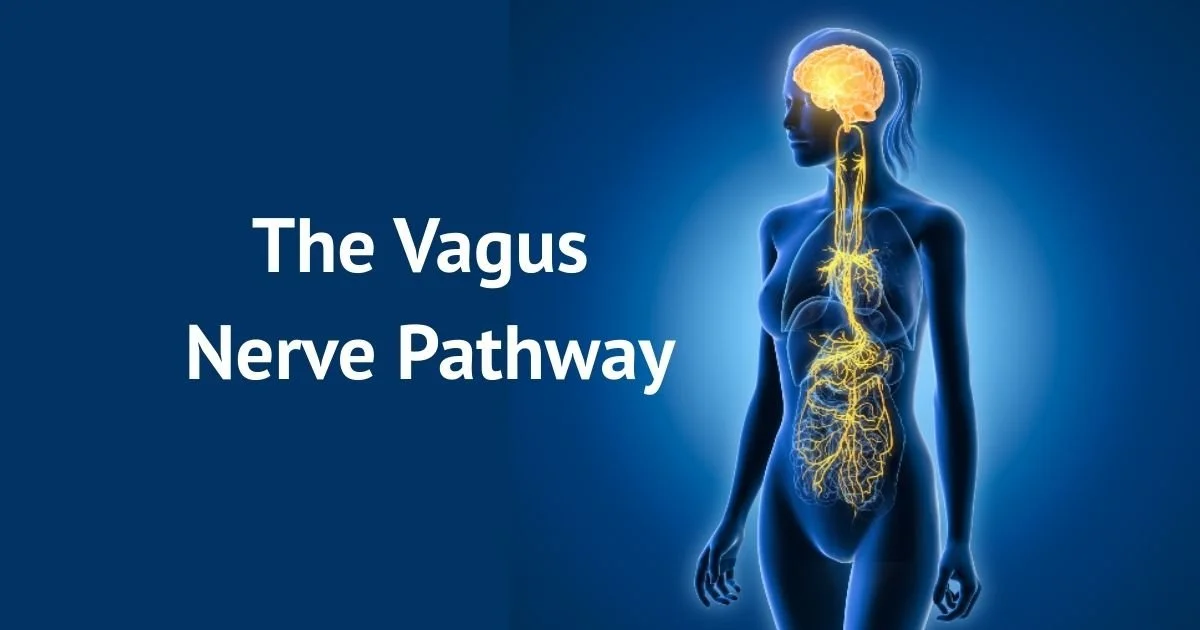The Vagus Nerve Explained
Updated: 09/18/2025
Vagus Nerve & Breathwork
Introduction
Have you ever noticed how a deep breath can bring instant relief in moments of stress? If you are a breathwork facilitator, you intuitively witness this shift in your clients all the time — but there’s powerful science behind it.
At the heart of this transformation is the vagus nerve: a wandering cranial nerve that links breath, body, and emotional well-being. Understanding its role helps us explain why breathwork reduces anxiety, regulates mood, and fosters a deep sense of calm.
Let’s explore how this amazing nerve works, why it matters for trauma-informed breathwork, and how we can consciously strengthen vagal tone through breathing practices.
Table of Contents
What is the Vagus Nerve?
It’s become something of a buzzword in wellness and neuroscience circles, but let’s take a moment to demystify this vital nerve.
Cranial Nerves: The Body’s Direct Line from Brain to Body
The vagus nerve is one of twelve cranial nerves that originate directly from the brain. Each cranial nerve has a specialised function essential for daily living, and together they create a sophisticated communication network between the brain, head, and body.
Cranial nerves are numbered from I to XII and include everything from the optic nerve (vision) and olfactory nerve (smell) to those responsible for taste, hearing, swallowing, and facial movement. Some are purely sensory, some are purely motor, and others (like the vagus nerve) perform both roles.
This dual sensory–motor functionality means cranial nerves don’t just collect information — they also send instructions back out. For example, they allow you to smile when you feel happy, swallow when you taste something delicious, or orient yourself when hearing sound. In short, they bridge the gap between what we perceive, how we feel, and how we respond.
The Vagus Nerve: Your Internal Communication Network
Among the cranial nerves, the vagus nerve (cranial nerve X) stands out as the longest and most complex. Its name comes from the Latin vagari, meaning “to wander”, because unlike other cranial nerves that stay within the head, the vagus nerve extends far beyond.
It branches from the brainstem down through the neck and chest into the abdomen, connecting with vital organs such as the heart, lungs, and digestive tract. You might imagine it as a superhighway of communication, carrying essential information up and down between the brain and body.
As the main nerve of the parasympathetic nervous system (“rest and digest”), the vagus nerve regulates many unconscious processes that keep us alive and balanced:
Heart rate and blood pressure
Breathing rhythms
Digestion and gut health
Inflammatory responses
But its role goes even further. The vagus nerve is also deeply involved in mood regulation, emotional resilience, and stress response, showing just how tightly our physiology and psychology are intertwined. Its influence across both physical and emotional health makes it a central focus for researchers studying stress, trauma, and healing [1].
How the Vagus Nerve Communicates
Here’s a simplified look at how information travels along this fascinating pathway:
Sensory (Afferent) Fibres: Around 80% of vagus nerve fibres carry messages upward from the body to the brain. These signals report on heart rate, blood pressure, gut sensations, and more, giving the brain a constant update on your internal state [1].
Motor (Efferent) Fibres: The other fibres send messages downward from the brain to the body, helping regulate heart function, breathing, digestion, and even immune and inflammatory responses [1].
This constant two-way communication helps maintain homeostasis — a stable, balanced internal environment.
The “Rest and Digest” Master Switch
The vagus nerve is especially important because of its role in switching the body from stress mode (“fight or flight”) into relaxation mode (“rest and digest”).
When activated, it sends a cascade of calming signals throughout the body:
Heart rate slows
Blood pressure lowers
Digestion and nutrient absorption improve
The body releases stress-reducing hormones
Inflammation is kept in check
In other words, the vagus nerve is like an internal master switch for healing and recovery. By helping us downshift into parasympathetic dominance, it supports both physical repair and emotional balance [2].
This is why practices that stimulate the vagus nerve — such as breathwork — can feel so profoundly regulating, grounding, and restorative.
The Vagus Nerve Pathway (in yellow)
The Vagus Nerve and Emotional Health
A single breathwork session can leave someone feeling lighter, calmer, and more present in their body. At the heart of this shift is the vagus nerve.
When vagal tone is strong — meaning the vagus nerve is responsive and flexible — people tend to feel steady, resilient, and able to navigate stress without becoming overwhelmed. On the other hand, low vagal tone is often linked to anxiety, poor emotional regulation, and difficulty returning to calm after stress. This makes the vagus nerve a central player in emotional well-being and resilience.
Polyvagal Theory: A Deeper Understanding
One of the most useful frameworks for understanding the vagus nerve is Polyvagal Theory, developed by Dr Stephen Porges [2]. This theory proposes that our autonomic nervous system doesn’t just have two states (calm vs. stress), but a range of responses that shape how we experience safety, danger, and connection.
According to Polyvagal Theory:
Ventral vagal state – The most evolved branch of the vagus nerve, linked with safety, social engagement, play, and connection. In this state, people feel open, emotionally regulated, and able to connect with others.
Sympathetic state – When a threat (real or perceived) arises, the body activates “fight or flight.” Heart rate increases, adrenaline surges, and vagal function is temporarily dampened. This is a natural survival mechanism — but if it becomes chronic, it can create anxiety, hypervigilance, and difficulty calming down [2].
Dorsal vagal state – In extreme or prolonged stress, the system may shut down into a freeze response. This can look like numbness, disconnection, or dissociation, where the body protects itself by withdrawing. In this state, dorsal vagal dominance overrides both social engagement and sympathetic activation [2].
For facilitators, recognising these states is invaluable. It helps us understand why some clients become restless or anxious during breathwork, while others may feel heavy, flat, or dissociated.
The Vagus Nerve and Emotional Regulation
The vagus nerve serves as a bridge between body and brain, directly shaping emotional health [3]. Its functions influence:
Heart rate and heart rate variability (HRV) – key markers of resilience.
Breathing rhythms – which shift naturally with stress and calm.
Digestion and gut-brain connection – a healthy vagus nerve supports the microbiome, which in turn influences mood and mental health [1].
When vagal tone is strong, the body can more easily downshift into calm: slowing the heart rate, deepening the breath, and restoring balance after stress. This doesn’t just help in the moment — over time, it builds a foundation of emotional resilience and flexibility.
Rebuilding Vagal Health
The best part is that the vagus nerve can be strengthened and restored. Practices like breathwork, mindfulness, gentle movement, and social connection help the nervous system re-pattern itself.
For those living with anxiety or trauma, this is really hopeful. Even if the nervous system has been stuck in hyperarousal or shutdown, consistent practice can help bring it back into balance. Breathwork offers a direct, accessible pathway to improving vagal tone — helping clients feel calmer, more connected, and more capable of navigating life’s challenges [3].
How Breathwork Stimulates the Vagus Nerve
Now for the part we know and love – breathwork. We hold one of the most powerful, accessible tools for directly influencing the vagus nerve. Conscious breathing can act like a reset button for the nervous system, shifting someone from stress and tension into calm and regulation.
But how does this actually work? Let’s look at the mechanisms behind breathwork’s impact on vagal tone.
Baroreceptor Stimulation
Within your lungs and arteries are baroreceptors — tiny stretch sensors that detect changes in pressure and volume. When you practise slow, deep breathing, these receptors are gently stimulated.
The messages travel up through the vagus nerve to the brainstem, signalling “you are safe.” This down-regulates the sympathetic “fight or flight” response and shifts the body toward parasympathetic dominance [4]. For clients, this can feel like the nervous system unclenching after being on high alert.
Diaphragmatic Engagement
The diaphragm — our primary breathing muscle — is closely linked with the vagus nerve. When we breathe shallowly, the diaphragm barely moves, and the vagus nerve receives little stimulation. But when we engage in diaphragmatic (belly) breathing, the diaphragm moves fully, gently massaging internal organs and sending a steady stream of calming signals via the vagus nerve.
This physical engagement is one reason belly breathing is so grounding and why it’s often the first technique we teach clients [5].
Heart Rate Variability (HRV)
Breathwork also influences heart rate variability (HRV) — the natural variation in the time between heartbeats. A high HRV is a marker of good vagal tone and nervous system flexibility, while low HRV is associated with stress, anxiety, and poor health outcomes.
Slow, intentional breathing increases HRV, training the body to be more adaptable. Over time, this builds a more resilient nervous system — one that can return to balance more quickly after stress [5].
Rhythmic Patterning
Breathwork techniques that emphasise rhythm — such as Alternate Nostril Breathing or Coherent Breathing — stabilise the nervous system by creating resonance between the heart, lungs, and brain.
Breathing at around 5–6 breaths per minute is especially effective. This rhythmic entrainment strengthens vagal activity, leading to a more stable and calm internal state [5].
Benefits for Health and Well-Being
These physiological shifts don’t just feel pleasant in the moment — they help repattern the nervous system over time. Consistent conscious breathing leads to improved vagal tone and lasting benefits for mental, emotional, and physical health.
Reduced Anxiety – Slowing the nervous system helps ease worry, agitation, and overwhelm [5].
Improved Mood – Increased vagal tone is linked with more positive emotions, resilience, and overall well-being [5].
Stronger Stress Response – With a healthy vagus nerve, the body can bounce back more quickly after challenges, reducing the impact of stressors on long-term health.
Better Gut Health – Because the vagus nerve regulates digestion, supporting it through breathwork may also contribute to a healthier microbiome, which plays a role in mood regulation [1].
For facilitators, this means that every breathing practice you guide has the potential not only to calm a client in the present moment, but also to strengthen their nervous system in the long term.
Want to experience these benefits yourself? Join our Free Weekly Guided Breathwork Sessions and explore techniques that directly support vagal tone.
Best Breathing Techniques for Vagal Tone
Many breathing exercises can stimulate the vagus nerve. Some favorites include:
Other Ways to Strengthen the Vagus Nerve
While breathwork is one of the most direct and effective ways to support vagal tone, the vagus nerve responds best when we take a holistic approach to nervous system care. This means weaving in simple, everyday practices that nourish body, mind, and emotional health alongside conscious breathing.
Here are some additional ways to nurture your vagus nerve and build long-term resilience:
Social Connection
The vagus nerve is deeply linked to our social engagement system, which explains why we feel more regulated in safe, supportive relationships. Spending time with loved ones, sharing a laugh with friends, or even stroking a pet can stimulate the vagus nerve and promote feelings of safety.
As facilitators, creating an atmosphere of warmth, trust, and connection during sessions helps clients strengthen this pathway simply through co-regulation.
Gentle Movement
Movement supports vagal function by releasing physical tension and restoring fluidity to the nervous system. Activities like yoga, tai chi, mindful walking in nature, or even dancing activate parasympathetic pathways and improve vagal tone.
Unlike high-intensity exercise (which activates “fight or flight”), gentle, mindful movement signals the body that it is safe, encouraging deeper relaxation.
Singing, Humming, and Chanting
Your vocal cords are directly connected to the vagus nerve. Engaging them through humming, chanting, or singing stimulates vagal pathways while also promoting joy and self-expression.
This is why sound-based practices such as mantra, toning, or group singing circles can be so regulating. Even a simple daily hum or soft “om” can provide a mini nervous system reset.
Cold Exposure
Short bursts of cold exposure — such as a cool shower, splashing cold water on your face, or placing an ice pack on the neck or cheeks — can temporarily activate the vagus nerve. This technique is sometimes used clinically to regulate heart rhythms and reduce anxiety.
It’s important to approach this practice with caution and gradual progression, especially for clients with health conditions. For some people, the shock of cold can be overwhelming rather than calming, so always prioritise choice and safety.
Mindfulness and Presence
Practices that bring us into the present moment — such as meditation, body scans, or simple sensory awareness — have a calming effect on the nervous system. By reducing rumination and orienting us to safety in the here and now, mindfulness naturally supports vagal function.
Even small daily moments of presence — like pausing to notice your breath, listening to birdsong, or grounding through touch — can strengthen parasympathetic pathways over time.
A Trauma-Sensitive Reminder
For clients with trauma histories, some of these practices may not feel safe or accessible right away. In these cases, it’s vital to start small and honour personal pacing. Even gentle breath awareness or co-regulation with a trusted facilitator can begin to shift vagal tone.
The key is consistency, compassion, and creating a toolkit of practices that feels supportive, not overwhelming.
The Vagus Nerve, Trauma, and Safety
In moments of danger (perceived or real), the body’s survival systems take over. Sometimes that looks like fight or flight — a surge of energy and alertness. Other times, it looks like freezing or shutting down to avoid overwhelm. These are protective responses, not flaws. The challenge comes when these states linger long after the original threat has passed, leaving the body wired for stress or withdrawal.
Restoring Safety
The good news is that the vagus nerve is very adaptable! Small, repeated experiences of safety can gently retrain the nervous system. This might mean:
Practising slow breathing to signal calm
Spending time with people (or pets) who feel supportive
Engaging in grounding activities like walking in nature, listening to music, or mindful movement
Seeking trauma-informed therapeutic support if needed
These everyday practices reassure the nervous system that it can let go of hypervigilance and return to steadier states.
A Closing Thought
If you’ve experienced stress or trauma, it’s natural for your nervous system to feel unsettled. The vagus nerve simply reflects what your body has been through. With patience and gentle practice, its tone can improve, helping you feel more connected, resilient, and at ease.
Want to Go Deeper?
If you’d like to explore these practices in a deeper, guided way, check out our Breathwork Courses or join one of our Breathwork Retreats. They’re designed to support nervous system regulation, resilience, and personal transformation.
Reference List
Breit, S., Kupferberg, A., Rogler, G., & Hasler, G. (2018). Vagus Nerve as Modulator of the Brain–Gut Axis in Psychiatric and Inflammatory Disorders. Frontiers in Psychiatry, 9, 44. https://doi.org/10.3389/fpsyt.2018.00044
Jerath, R., Crawford, M. W., Barnes, V. A., & Harden, K. (2015). Self-regulation of breathing as a primary treatment for anxiety. Applied Psychophysiology and Biofeedback, 40(2), 107-115. https://doi.org/10.1007/s10484-015-9279-8
Kember, G. C., Armour, C., & Dolmage, T. E. (2023). The Role of the Vagus Nerve in Mental and Physical Health and the Potential Therapeutic Applications of Vagus Nerve Stimulation. The Journal of Alternative and Complementary Medicine, 29(1), 1-17.
Kok, B. E., & Fredrickson, B. L. (2010). Upward spirals of the heart: Autonomic flexibility, as indexed by vagal tone, reciprocally and prospectively predicts positive emotions and social connectedness. Biological Psychology, 85(3), 432–436. https://doi.org/10.1016/j.biopsycho.2010.09.005
Porges, S. W. (2007). The polyvagal perspective. Biological Psychology, 74(2), 116-143. https://doi.org/10.1016/j.biopsycho.2006.06.009
Russo, M. A., Santarelli, D. M., & O'Rourke, D. (2017). The physiological effects of slow breathing in the healthy human. Breathe, 13(4), 298-309. https://doi.org/10.1183/20734735.009817
Frequently Asked Questions about the Vagus Nerve and Breathwork
-
Vagus nerve breathing is a way of using slow, intentional breathing to stimulate the vagus nerve. Techniques such as diaphragmatic (belly) breathing or extended exhalation activate parasympathetic pathways, which help the body shift into a calm, restorative state. Over time, this practice can improve vagal tone, supporting both emotional resilience and physical well-being.
-
When you breathe deeply, two things happen: baroreceptors in your lungs and arteries are gently stretched, and your diaphragm fully engages. Both of these actions send signals through the vagus nerve to the brainstem, telling your body it’s safe. This increases vagal activity, slows the heart rate, and helps calm the stress response.
-
Yes. The vagus nerve helps regulate breathing rhythms as part of the parasympathetic nervous system. When vagal tone is strong, breathing tends to be smooth and steady. If vagal function is impaired, breathing may feel shallow, irregular, or harder to regulate. Strengthening the vagus nerve through breathwork supports more consistent and calming breathing patterns.
-
Some of the most effective practices include:
Coherent breathing (about 5–6 breaths per minute)
These methods all improve vagal tone by activating parasympathetic pathways and enhancing heart rate variability (HRV).
-
Breathwork is one of the easiest daily practices, but it’s not the only one. You can also support vagal tone through:
Social connection with safe, supportive people
Gentle movement such as yoga, walking, or dancing
Humming, chanting, or singing
Short, gentle cold exposure (like a cool shower)
Mindfulness and grounding practices
These simple actions tell your nervous system that you’re safe, helping the vagus nerve reset and regulate more effectively.



